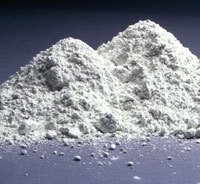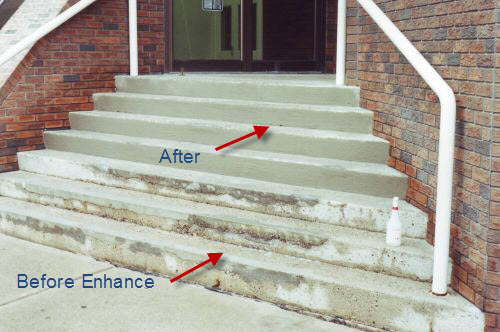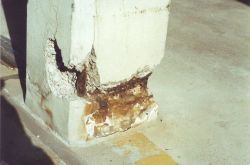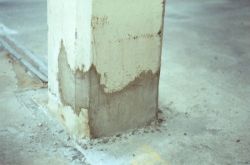About Cement
Cement
In engineering and building construction, cement usually refers to a finely powdered, manufactured substance consisting of gypsum plaster or Portland cement that hardens and adheres after being mixed with water.
Cements are used for various purposes, such as binding course and fine aggregates together with Portland cement to form concrete. When used with sands alone the purpose is generally to produce some form of plaster or mortar used in stucco or masonry mud. Cements are made in a wide variety of compositions for a wide variety of uses. Special blends of manufactured cement are named for the principal constituents, such as calcareous cement, which contains silica, and epoxy cement, which contains epoxy resins; for the materials they are intended to join, such as hydraulic cement, which hardens underwater, or acid-resisting cement, or quick-setting cement.

History
Although mineral-based hydraulic cements have ancient origins, hydraulic cements have been used only since the 18th century. In 1824, Joseph Aspdin, a British cement maker, took out a patent for “Portland Cement”, a material he produced by firing a mixture of finely-ground clay and limestone, because the concrete made from it looked like Portland stone, a widely used building stone in England. While Aspdin is widely regarded as the inventor of Portland cement, his son, William, found that a higher temperature causing a small proportion of the material to melt produced beneficial properties.
In 1845, William’s main competitor, Isaac Johnson, had also made an improved
cement, by firing a mixture of chalk and clay at higher temperatures. Because both William Aspdin and Johnson burnt at higher temperatures than had been used previously, minerals were produced which were very reactive and more strongly cementitious. The cements produced by both Aspdin and Johnson at higher temperatures can more accurately be considered the real forerunners of modern Portland Cement.
Three more important developments lead to modern Portland cement.
The first rotary kilns were introduced in the late 1800’s (Ransome, 1885: Hurry and Seaman, 1895). Also, around the end of the 19th century, the addition of gypsum to control cements setting properties, and the use of ball mills to grind clinker and raw materials, rounded out and refined the manufacturing of modern-day Portland cements.
This brief and selective whirlwind tour of cement development sets Portland cement in its historical context.
Portland Cement
There is great variety in the types of cement used in the construction industry. Cement is an integral ingredient in products such as concrete, mortar, and grout. By far the most important in terms of volume is Portland cement and those based on Portland cement.
Portland Cement is made by heating suitable raw materials, typically ground limestone and clay, at a temperature of about 1450 degrees celcius to produce a dark grey nodular material called clinker. At this temperature, much of the clinker remains solid but perhaps 20%-30% of the clinker is liquid, thinly-dispersed within the nodules. When cool, the clinker is ground up to a fine powder and a small amount of gypsum is added to control the setting properties of the cement.
Cement may be “pure” Portland cement, or, alternatively, it may be made from Portland cement mixed with other materials that also have cementitious properties, such as blast-furnace slag and fly ash.
Cements composed of mixtures of Portland cement with these other materials can enhance concrete properties; these mixtures are widely used and are called “composite cements” or “blended cements”. Due to technical developments as well as environmental concerns the use of composite or blended cements has grown dramatically.
Portland cement itself can be divided into a number of different types, each cement having different characteristics, such as high early strength, low heat of hydration, and high sulphate resistant.
As a brief aside, there are many other types of cement that are not based on Portland cement. However, the quantities of these other cements used are small compared with Portland cement and those based on Portland cement.
There are five principal types of manufactured cements as specified by the American Society for Testing and Materials (ASTM) under ASTM C-595. These are:
| ASTM Type | ASTM Designation |
Use |
| Type I (GU) | General purpose. (Most common) |
Suitable for use in all types of concrete work not subject to unusual exposure conditions. |
| Type II (MS) | Moderate Sulfate resistance. | Substituted for Type I where exposure to sulfate in soils or ground water is identified. |
| Type III (HE) | High Early strength. | A premium cost material used to speed form removal or for cold climates. |
| Type IV (LH) | Low heat. | For mass construction such as dams where low heat of hydration is desired. |
| Type V (HS) | Sulfate resisting. | Where severe sulfate exposure is identified. |
In Canada Standard A3001 created a new cement type system of identification whereby Types 10, 20, 30, 40, and 50 were renamed GU, MS, HE, LH and HS respectively. The most commonly manufactured is ASTM Type I (GU) which is used by most concrete producers.
Cement n (14c.) 1. A powder of alumina, silica, lime, iron oxide, and magnesium burned together in a kiln and finely pulverized and used as an ingredient of mortar and concrete also: CONCRETE 2. A binding element or agency.
A more precise definition of Portland Cement is that it is the ground product of Portland cement clinker, usually interground with a small amount of calcium sulfate to bring the total sulfate content of the cement to about 2.5%-4% by weight.
In turn, Portland cement clinker is produced from a mixture of finely-ground calcareous and siliceous components, together with a proportion of alumina and iron, as well as some impurities, fired in a kiln at a temperature of about 1450 degrees celcius.
Portland cement clinker contains four principal minerals, or ‘phases’:
- Alite
- Belite
- A calcium aluminate phase
- A calcium alumino-ferrite phase
The mineral names, approximate compositions, and chemistry notations of clinker minerals are contained in the following chart:
| Mineral Name | Approximate Composition |
Chemistry Notation |
| Alite | tricalcium silicate |
C3S |
| Belite | dicalcium silicate | C2S |
| Calcium aluminate phase | tricalcium aluminate | C3A |
| Calcium alumino-ferrite phase | tetracalcium aluminoferrite | C4AF |
Alite (tricalcium silicate; C3S)
Alite is very reactive in the presence of water. It is the main constituent of
Portland cement, typically between 45% and 70% of the clinker by weight. It is
the main strength-giving component of cement and is thus strongly hydraulic.
Belite (dicalcium silicate; C2S)
Belite is reactive and hydraulic, but less so than alite. The proportion of belite in
clinker typically varies between 5% and 30%.
Aluminate (tricalcium aluminate; C3A)
The aluminate phase is the most reactive constituent of clinker. However, it is
not a major contributor to strength in Portland cement, in other words it is only
very weakly hydraulic. Although only weakly hydraulic, because it is very reactive
it has a strong influence on early setting properties of cement and it produces a
lot of heat. In order to control this reactivity, gypsum is added to cement to
control the aluminate phase hydration.
Ferrite (tetracalcium aluminoferrite; C4AF)
Ferrite phase is moderately reactive, but only weakly hydraulic. It reacts quickly
initially when mixed with water but the rate of reaction slows and unhydrated
ferrite can be found in concrete over a hundred years old. Ferrite is black and
gives cement its characteristic grey colour.
Special Cements
By varying normal components or adding others, Portland cement can be given various desirable characteristics, such as rapid hardening (high-early-cement), low heat during hydration, and resistance to alkalis or sulfates. Some of these cements will set within minutes or harden as much in a day as ordinary cement does in a month. Special low-heat cements (high in dicalcium silicate), are generally used for massive concrete placements (bridge supports, dams). Where concrete exposed to alkaline conditions a resistant cement (low aluminum content) is employed. Cements for use under salt water may contain as much as 5 percent iron oxide, and those with as much as 40 percent aluminum oxide are used to resist the action of sulfate-soils.
Aggregates
Not considered here are the infinite combination of aggregate sources for concrete mixes or use of natural and man made pozzolans for use in diverse purpose-made material mixtures.
FACTORS AFFECTING CONCRETE PERFORMANCE
| An increase in: |
Will: |
| WATER | Increase slump and reduce strength. |
| AIR | Increase slump and reduce strength. |
| SLUMP | Extend set time*, and increase shrinkage/ cracking. |
| MIXING TIME | Reduce strength, increase temperature, and increase air. |
| TEMPERATURE | Reduce strength, slump, and set time. |
| * Except where slump is Increased by use of specific performance admixtures. |
Other factors that play a large role in the quality or integrity of hardened concrete are site preparation, discharge time, placement, consolidation, and finishing processes. The best concrete mix available can not make up for poor building practices.
PROBLEMS THAT START FROM WITHIN

Alkalies (Arabic al-qili, "ashes of the saltwort plant"), originally the hydroxides and carbonates of potassium and sodium, leached from plant ashes. As they apply to cements and concrete, in high enough concentration to destroy flesh; for this reason they are called caustic alkalies.
Alkali Metals, series of six chemical elements in group 1 (or Ia) of the periodic table. They are soft compared to other metals, have low melting points, and are so reactive that they are never found in nature uncombined with other elements. They are powerful reducing agents, that is, they give up an electron easily, and react violently with water to form hydrogen gas and hydroxides, or strong bases. The alkali metals are, in order of increasing atomic number, lithium, sodium, potassium, rubidium, cesium, and francium. Francium exists only in a radioactive form.


LINKS:
Promotions
 Would your company like to work with us? Contact Us to learn more about our joint venture program and cross-promotion opportunities.
Would your company like to work with us? Contact Us to learn more about our joint venture program and cross-promotion opportunities.







